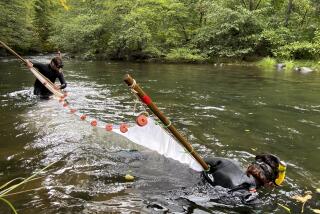A Parched River
- Share via
Should Southern Californians be bothered that long stretches of the San Joaquin River, hundreds of miles away, run dry every summer and fall as farmers take all the water to irrigate their crops? Absolutely, if they care about the water they drink.
As it descends from the Sierra, the river effectively dies for much of the year when it backs up behind Friant Dam north of Fresno. The water is diverted north and south along the east side of the San Joaquin Valley via irrigation canals. About 60 miles of the river go dry. It does pick up some flow from tributaries to the north, but that water is overwhelmed by polluted irrigation runoff. Victims of this shallow, foul stew include the historic salmon run up the San Joaquin. Ultimately, it flows into the Sacramento-San Joaquin Delta and out to San Francisco Bay.
In the delta, the huge pumps of the State Water Project send enough water to Kern County farms and urban users in Southern California to meet the household needs of 2 million families for a year. Pollution in the delta has been a major concern of the Metropolitan Water District of Southern California, which wholesales water to urban districts serving 18 million people from Ventura to San Diego.
A U.S. district judge ruled last year that the federal Bureau of Reclamation had violated a state fish and game law by allowing the river to go dry. A 1937 law requires dam operators to release enough water downstream to maintain the existing fisheries. The case is set for full trial next spring. A major unanswered question is how to find replacement water for the farmers if some of their supply has to remain in the stream.
A solution will take years to work out. But proposed legislation by state Sen. Michael Machado (D-Linden), due for a key committee test today, is one place to start. It would create a “San Joaquin River Fund” with $9 million remaining from a voter-approved state water bond issue. The money would help restore habitat along the river and pay for replacement water. It’s a small start, but it takes a first step to reviving a dead river and bringing cleaner water to Southern California. Southern California legislators need to think about their stake in this faraway river.
More to Read
Sign up for Essential California
The most important California stories and recommendations in your inbox every morning.
You may occasionally receive promotional content from the Los Angeles Times.










